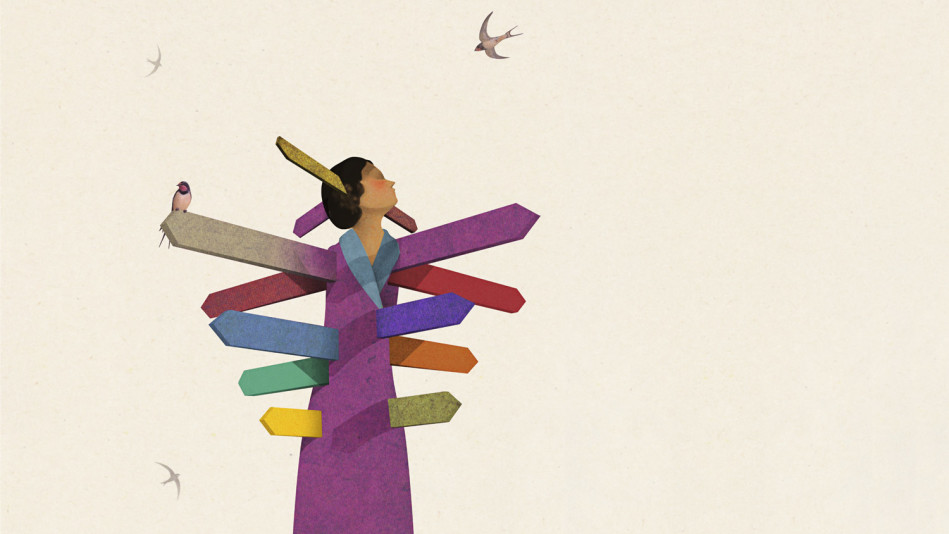What to Do if You Overthink Everything
Thinking through all your options is great, but not if you're left paralyzed with indecision. Here's what to remember the next time you're faced with a decision you can't make.

Illustration: Brett Ryder
You're a thoughtful person who considers all the angles—that's why everybody seeks your advice. But now you're over-analyzing, so busy looking that you can't leap. The more time you spend thinking about what you should do, the less able you are to do anything at all.
Find something to believe in and commit to it.
1. Remember: Not choosing is a choice.
Consider the philosophical paradox of Buridan's ass, who's standing an equal distance between two stacks of hay. Unable to decide between the two, he dies of hunger.
Post-it quote: "Sometimes, making the wrong choice is better than making no choice. You have the courage to go forward, that is rare. A person who stands at the fork, unable to pick, will never get anywhere." —Terry Goodkind, Wizard's First Rule
2. Lose your focus.
You'll benefit from clearing the mental clutter, so for a set period, forget about the problem. Then try free association: Letting your mind wander calms your thoughts and makes way for feelings. Now consider your choices and write the first word that comes to mind. Then write the next word. Keep going and see what happens.
3. Give yourself a hard out.
No negotiating! You can think in terms of...
• Time:
I'll decide after_____ days/hours.
• Repetition:
I'll decide after _____ drafts/versions.
• Research:
I'll decide after I've checked _____ sources.
• Input:
I'll decide after I've discussed it with _____ people.
4. Do a gut check.
Write your choices on separate slips of paper and fold them into squares, then throw them in the air and pick the one that lands closest. When you read what's inside, check your physical reaction. Are you holding your breath or sighing in relief? Do you feel lighter or heavier? Let your response be your guide.
5. Get your options in a row.
If you have several, create a master list with the benefits of each. It may not make your decision easier, but you'll be less likely to regret the outcome. According to research from the Wharton School of the University of Pennsylvania, when we consider choices sequentially—should I do A or B? B or C? C or D?—we're left thinking that something better could come along. When we consider all our options at once, it's easier to manage our expectations.
Your assignment
Find something to believe in and commit to it.
1. Remember: Not choosing is a choice.
Consider the philosophical paradox of Buridan's ass, who's standing an equal distance between two stacks of hay. Unable to decide between the two, he dies of hunger.
Post-it quote: "Sometimes, making the wrong choice is better than making no choice. You have the courage to go forward, that is rare. A person who stands at the fork, unable to pick, will never get anywhere." —Terry Goodkind, Wizard's First Rule
2. Lose your focus.
You'll benefit from clearing the mental clutter, so for a set period, forget about the problem. Then try free association: Letting your mind wander calms your thoughts and makes way for feelings. Now consider your choices and write the first word that comes to mind. Then write the next word. Keep going and see what happens.
3. Give yourself a hard out.
No negotiating! You can think in terms of...
• Time:
I'll decide after_____ days/hours.
• Repetition:
I'll decide after _____ drafts/versions.
• Research:
I'll decide after I've checked _____ sources.
• Input:
I'll decide after I've discussed it with _____ people.
4. Do a gut check.
Write your choices on separate slips of paper and fold them into squares, then throw them in the air and pick the one that lands closest. When you read what's inside, check your physical reaction. Are you holding your breath or sighing in relief? Do you feel lighter or heavier? Let your response be your guide.
5. Get your options in a row.
If you have several, create a master list with the benefits of each. It may not make your decision easier, but you'll be less likely to regret the outcome. According to research from the Wharton School of the University of Pennsylvania, when we consider choices sequentially—should I do A or B? B or C? C or D?—we're left thinking that something better could come along. When we consider all our options at once, it's easier to manage our expectations.



